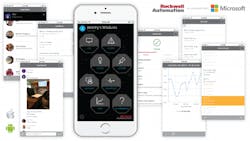Thoroughly modern mobility: Are you making the most of mobility in your asset management strategy?
It wasn’t long ago that plant service work revolved around stationary workstations. Maintenance, inventory, and supervisory personnel needed these computers to find their work schedules and instructions, log activity, and review job statuses. Mobile solution developments are saving an extraordinary amount of time in the plant, the storeroom, and out in the field, and the benefits extend to greater safety, performance and reliability.
Still, there are underutilized opportunities for mobility in enterprise asset management (EAM/CMMS) as well as lingering challenges to implementation. Analysts, end users, and solution providers are actively addressing these concerns and looking to the future. Following are what some of them have to say.
The industry analyst outlook
Mobile devices allow maintenance engineers to have access to information about the equipment they are maintaining, even when they are a long way from the control room, says Andrew Hughes, Principal Analyst at LNS Research. They can do the necessary control before maintenance and can access any manuals or help they need to carry out a job.
Maintenance is not the only beneficiary of mobility. “We think too often about managers and supervisors getting consolidated information, but the people who can really make a difference to the quality and speed of product in a factory – the operators – often do not have immediately available information when they are away from their fixed workstation. This should be changed everywhere if we are to get the most out of our people,” advises Hughes.
He is witnessing modern technologies augment the capabilities of conventional mobile devices. “In manufacturing operations, we are already seeing a substantial uptake in devices that go beyond the simple tablet or phone, for example wearable bar code readers, NFC-enabled devices for near field communication, or even RFID devices to detect where a person, product, or piece of equipment is currently located,” says Hughes.
Another example is sensors that not only know about location but can also track the condition of a product. For example, an active ingredient in a pharmaceutical supply chain might have sensors to read the temperature and humidity where it is stored, and automatically copy that information to the production plant and line that will use it.
One big opportunity will be in augmented reality (AR), especially in complex discrete manufacturing where AR can help operators and installation engineers to better understand the complex assembly tasks they need to undertake. “Lots of people are already talking about this. The companies to watch are the major PLM vendors as they already have 3D design and simulation capabilities built into their systems,” suggests Hughes.
The mobile service provider perspective
Mobility usage is pervasive at Jacobs, a provider of technical, professional and construction services to the industrial space. Jacobs uses mobile CMMS directly, middleware software to access the CMMS, and specialty software depending on the location and client. Devices include ruggedized tablets, off-the-shelf netbooks, tablets, and handheld PDAs.
“Mobile devices provide real-time visibility and capability in the field, allowing technicians and supervisors to access engineering support, review a drawing, or keep a close eye on inventory,” says Sherry Stovall, Maintenance Reliability Professional at Jacobs. “Our experience shows readily available information boosts craft productivity, improves work quality, and empowers our people in the field to make better decisions so asset management leaders can focus their efforts on asset improvements and innovation.”
Jacobs’ field personnel are empowered to make real-time decisions; as a result they’re engaged, enthusiastic, and more productive. Key performance indicators are available directly from the CMMS without additional reporting or data entry, improving performance management. Additionally, with real-time visibility on critical data, on-site inventory and data quality improves. It simplifies time keeping, requisitions as well as cost accounting associated with an asset, and eliminates dual data entry.
Incorporating mobility required some effort. “Initially, our biggest challenges were the cost benefit analysis and the comfort level of our craft and supervisors,” explains Stovall. “We had to help everyone understand what mobility really is, how it can benefit the project, and why it should be a standard tool, like a torque wrench or multi-meter. Now, our main challenge is providing a sustainable solution as hardware and software technologies consistently improve. We want to continually improve and expand the use of mobility for asset management.”
Jacobs is also working on data standards to enable more enterprise-level visibility and decision making relative to maintenance strategies. “We’re figuring out how to incorporate analytics in the field using condition-based maintenance technologies, and teaching our technicians to use technology to determine what maintenance to perform rather than just reading a job plan,” says Stovall.
The solution provider mission
Companies such as Microsoft, Rockwell Automation, Kyocera Communications, and IFS North America are working with customers and each other to simplify the mobility experience and fill gaps in work processes.
“We need to come together as an industry to create applications and services that leverage the power of personal devices while putting people in control of their data,” suggests Yaron Goland, Principal Developer at Microsoft. “How do devices find and communicate with each other regardless of the availability of a Wi-Fi or cellular infrastructure? It turns out that unreliable connectivity is a big problem for the Industrial Internet of Things (IIoT).”
Microsoft believes that edge devices that provide entry points into networks are underutilized in the industrial space. “We are working with partners like Rockwell Automation to enable entirely new scenarios that leverage the power of mobile devices and the intelligence of the cloud. The result is new levels of productivity that can be achieved with very low barrier/cost to implementation,” explains Goland.
Rockwell Automation and Microsoft’s co-innovation project addresses industrial environments where a wireless network connection is not always reliable. “Project Stanton’s main goal is to increase productivity by 33 seconds per hour instantly for every industrial role with zero friction. This means to break through all the technical barriers to value, and focus on enabling collaboration between people and devices in a secure and progressive way,” says Kyle Reissner at Rockwell, IA Mobility Platform Leader at Rockwell Automation.
The project has driven a new extensible app platform, built for industry, that enables customers to use it right away, realize what mobile can do for them, and then go after new use cases using the platform to drive more productivity improvements. “Don’t just buy technology for technology’s sake,” cautions Reissner. “We all need to focus on the value outcome and identify even the small opportunities – like ones that save 33 seconds per hour per employee – because those add up when applied to the entire plant. We believe our new app platform on company or personally owned devices can do this.”
Another distinction of Project Stanton is that customers do not need to connect their assets, controllers, drives, or automation systems to the cloud to get mobile. “Traditionally, customers are required to do this in order for anything to be delivered to a tablet or phone,” explains Reissner.
All mobility initiatives require a mindset and willingness to embrace training and process changes, suggests Muzib Khan, Sr. Director of Corporate Planning at Kyocera Communications. “Sometimes these changes are rushed, without sufficient time to study the existing process, research and source the best solution, and implement it methodically to cater to all levels of users. In addition, there can be issues with wireless network coverage due to shielding and other RF interferences.”
Solutions chosen must be convenient and easy to use, yet issues like data security, device durability, and price are also of major concern. Kyocera addresses such concerns with smartphones and feature phones that combine rugged durability, affordability, and interoperability with a wide array of enterprise software solutions and hardware accessories.
“Rugged devices are proven to offer better ROI and lower TCO,” says Khan. “Rugged mobile solutions enable real-time information sharing across the enterprise to facilitate faster decision making, which has a direct impact on overall productivity and a culture of collaboration. Mobility also enables greater data gathering and big data analytics to further improve manufacturing efficiencies by removing the traditional bottlenecks.”
There are evolutions in the capabilities that mobility provides, observes Rick Veague, CTO at IFS North America. For instance, if an automated machine tool trends out of tolerance for eight hours, the plant will have manufactured eight hours worth of scrap. Someone with a mobile device could have reacted to the trend earlier and minimized the scrap. Extending mobility to sensors, IIoT, and data analytics enables predictive intervention measures to avoid the scrap entirely and gives planners the luxury of planning corrective actions at a convenient time.
Another example of this evolution is applied to the way IFS Applications tracks assets and their geospatial locations. “By leveraging wearables, location awareness, and some virtual reality technology, we have shown that technicians wearing smart glasses can ‘look’ at an asset, determine its location, look up the asset information, and immediately ‘recognize’ the asset and view its current operational status and previous maintenance history,” says Veague. “Looking at a field of wind turbines, for example, an engineer can immediately ‘see’ which ones need service.”
Like all new technologies, there are challenges to overcome as the technologies mature, explains Veague. “The biggest challenge in my view, without question, is the vision of an organization to think outside the box and imagine new ways of working. Funding, executive support, time to learn and implement, user resistance, and IT resistance are other issues that must be overcome.”
To those on the fence about mobility, Veague suggests, “Do it! Pick a small project and see what can be learned, but expect challenges along the way. User experience is key to successful adoption, but the pay off in real-time visibility and efficiency is more than worth it.”
[sidebar id="5"]




